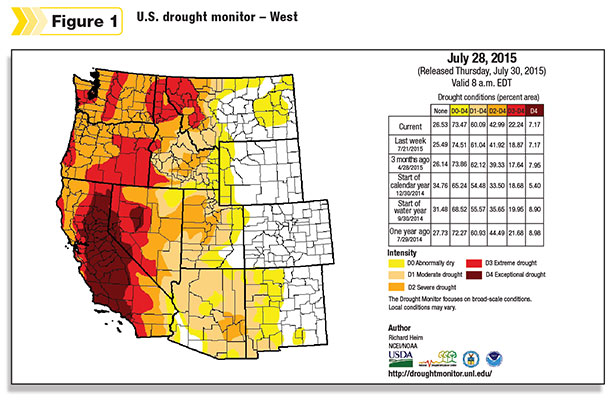These specialists discussed the different types of drought, practices producers have implemented to conserve water and why Arizona has few problems.
“We manage for scarcity,” said Bas Aja, executive vice president of Arizona Cattle Growers Association. “We understand water will be scarce. Not today, not tomorrow, but it will come soon.”
According to Aja, there are four kinds of drought: weather, man-made, infrastructure and planning. Weather induced droughts are inevitable, but the other three kinds can be prevented. Man-made droughts happen when different restrictions are placed on water resources. Aja used the Endangered Species Act as an example of a restriction that limits water use for many farmers and ranchers. Infrastructure and planning droughts occur when very little time and money are invested into conservation practices and there are insufficient plans for the future.
“The state next to us [California] is suffering from all four of these,” Aja said.
According to the U.S. Drought Monitor, nearly half of California is facing the worst type of drought (see Figure 1). This past January, California Gov. Jerry Brown declared a drought state of emergency.

“The government does a real good job handling the extremes of flooding and drought, but it’s in the middle they don’t operate very well,” Aja said. “You have to be developed for the middle, not the extremes.”
To help cattle producers sustain themselves in the “middle,” Arizona has encouraged ranchers to transition from stock ponds to spring- and well-based pipelines. David Brown, a cattle producer and an attorney who represents irrigation companies, said the transition has decreased overall water use.
“Agriculture in Arizona is the great repository for handling drought,” Brown said, “because it can conserve in different ways.”
Brown has implemented this on his own cattle operation, 900 cow-calf pairs in eastern Arizona, and he has found it to be very successful. Brown said the pipelines help disperse cattle drinking areas, which enable the cattle to spread their grazing out even more. According to Brown, because the cattle spread out more the overall use of pasture forage is increased.
According to the director of the Arizona Department of Water Resources, Tom Buschatzke, 73 percent of Arizona water is used for agricultural purposes and more than 85 percent of green, leafy vegetables are produced in southwest Arizona. Water conservation practices such as drip irrigation and multi-crop fields are necessary to survive the desert terrain.
Arizona has been preparing for the Colorado River water shortage, when less river water will be allotted to the state, and has accumulated 9 million acre-feet of groundwater storage, according to Buschatzke. The shortage will affect Arizona, Nevada and Mexico.
“This is why Arizona is doing so good, because of a long time working, planning and developing these plans,” Aja said. “We are always working and planning for where we live today and everyday.”
Sandy Fabritz, the director of water strategy with the mining company Freeport-McMoRan, explained why other states have infrastructure and planning droughts.
“Eventually it’s going to rain in the West,” Fabritz said. “Stock ponds are going to fill up, and people are just going to forget about the drought.” PC
PHOTO: Arizona industry professionals speak to agricultural journalists about the drought in the West. Left to right: Director of the Arizona Department of Water Resources Tom Buschatzke, Freeport-McMoran Director of Water Strategy Sandy Fabritz, Arizona Cattle Growers Association Executive Vice President Bas Aja and David Brown, a cattle producer and attorney. Photo by Jamie Keyes.








